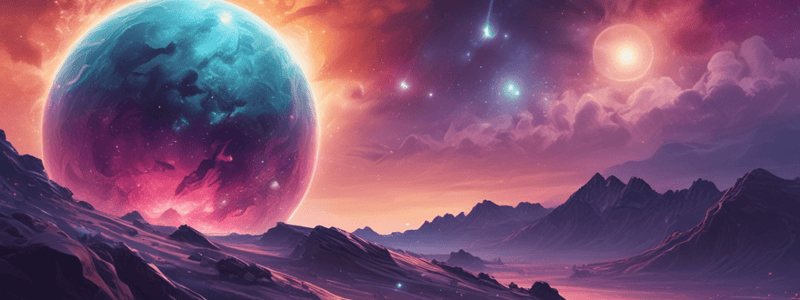Podcast
Questions and Answers
What event leads to the formation of a neutron star?
What event leads to the formation of a neutron star?
- A black hole formation
- A white dwarf's collapse
- A red giant phase
- A supernova explosion (correct)
What does the core of a neutron star primarily consist of?
What does the core of a neutron star primarily consist of?
- Neutrons (correct)
- Protons and electrons
- Hydrogen and helium
- Black hole mass
What is the approximate diameter of a neutron star?
What is the approximate diameter of a neutron star?
- 50 miles
- 100 miles
- 20 miles
- 12 miles (correct)
What happens to a star that is around the size of our sun when it dies?
What happens to a star that is around the size of our sun when it dies?
How does the mass of a neutron star compare to that of our sun?
How does the mass of a neutron star compare to that of our sun?
What will happen if a star is too massive when it dies?
What will happen if a star is too massive when it dies?
What allows neutrons to form inside a neutron star?
What allows neutrons to form inside a neutron star?
Which of the following statements about neutron stars is true?
Which of the following statements about neutron stars is true?
What characterizes the extreme density of a neutron star?
What characterizes the extreme density of a neutron star?
What is a necessary condition for a star to eventually become a neutron star?
What is a necessary condition for a star to eventually become a neutron star?
How do pulsars resemble lighthouses?
How do pulsars resemble lighthouses?
What happens to pulsars after millions of years?
What happens to pulsars after millions of years?
How many pulsars are estimated to exist in the universe?
How many pulsars are estimated to exist in the universe?
What primarily happens during the formation of a pulsar?
What primarily happens during the formation of a pulsar?
What is the significance of a pulsar's rotation to its appearance?
What is the significance of a pulsar's rotation to its appearance?
Why might observers perceive pulsars as 'newbies'?
Why might observers perceive pulsars as 'newbies'?
In what way are pulsars similar to Radio City Music Hall Rockettes?
In what way are pulsars similar to Radio City Music Hall Rockettes?
What is the role of radiation emitted by pulsars?
What is the role of radiation emitted by pulsars?
What phase comes after pulsars have finished their spinning period?
What phase comes after pulsars have finished their spinning period?
Flashcards are hidden until you start studying
Study Notes
Neutron Star Formation
- Neutron stars form following a supernova, resulting in smaller and denser remnants of massive stars.
- A neutron star originates from a star that was 4-8 times the mass of the Sun, which undergoes a core collapse after nuclear fusion ceases.
- The core's collapse allows protons and electrons to combine, creating neutrons, hence the name "neutron star."
Neutron Star Characteristics
- Neutron stars measure about 12 miles in diameter but possess a mass several times greater than the Sun.
- They are among the universe's densest objects; a single teaspoon can weigh millions of tons on Earth.
- The relationship between mass and size is counterintuitive—greater mass leads to a smaller size.
Star Evolution
- Stars larger than about 8 times the Sun’s mass may become black holes due to extreme density and gravitational forces.
- Stars too small, similar in size to our Sun, end as white dwarfs, lacking the density to undergo neutron star evolution.
Pulsars
- Pulsars are a type of neutron star characterized by rotation, giving them a blinking appearance to observers on Earth.
- This blinking effect occurs as they emit beams of radiation, analogous to a lighthouse, appearing and disappearing as they spin.
- New neutron stars that still have enough energy to spin are known as pulsars, which eventually cease their rotation over millions of years.
- An estimated 1,000 pulsars exist in the universe, whereas there are millions of neutron stars overall.
Studying That Suits You
Use AI to generate personalized quizzes and flashcards to suit your learning preferences.




